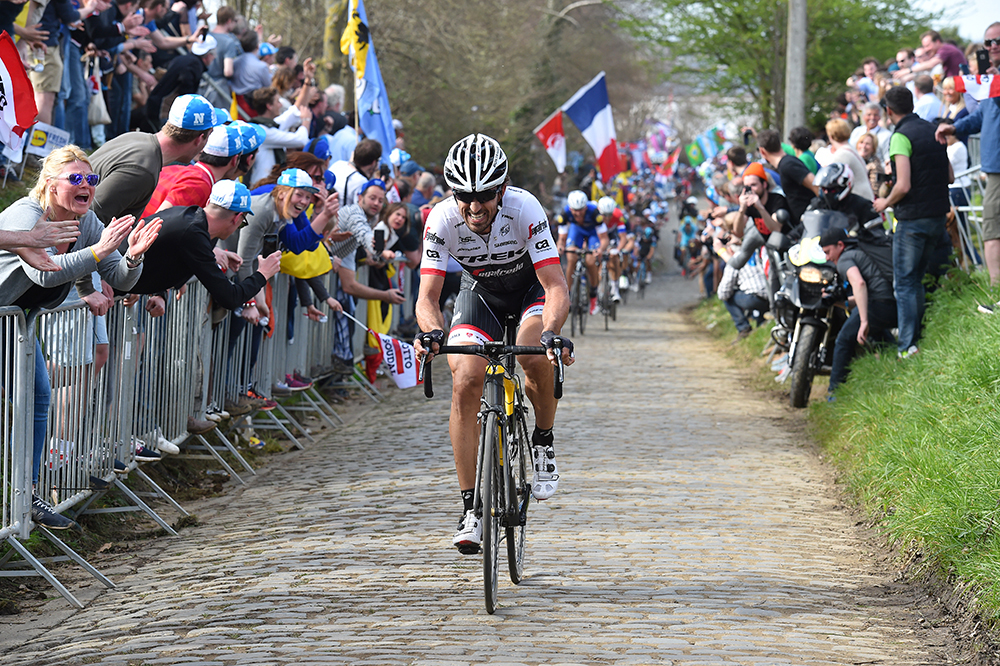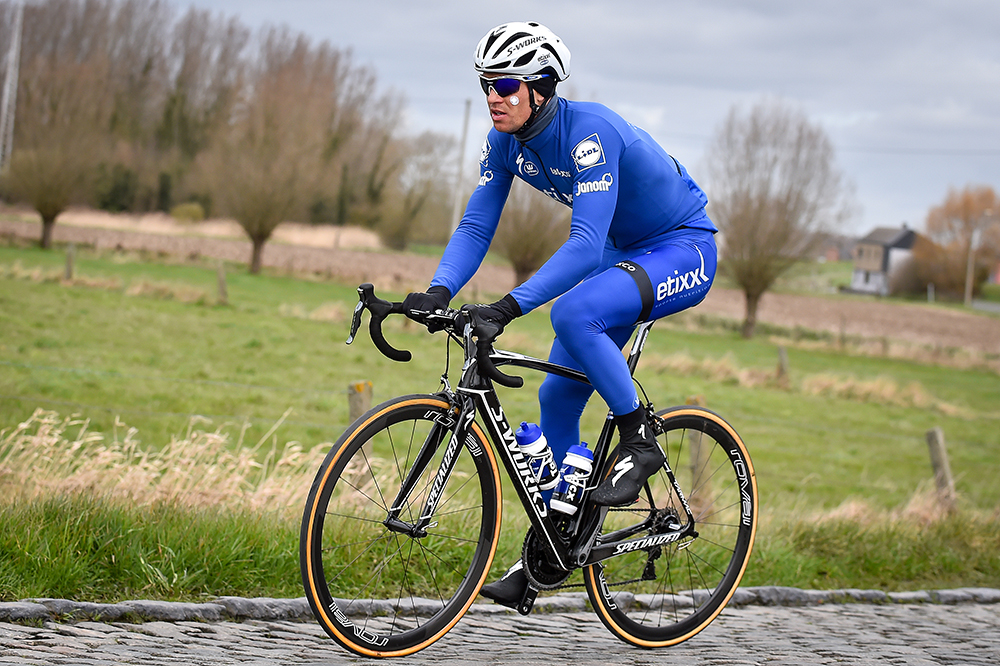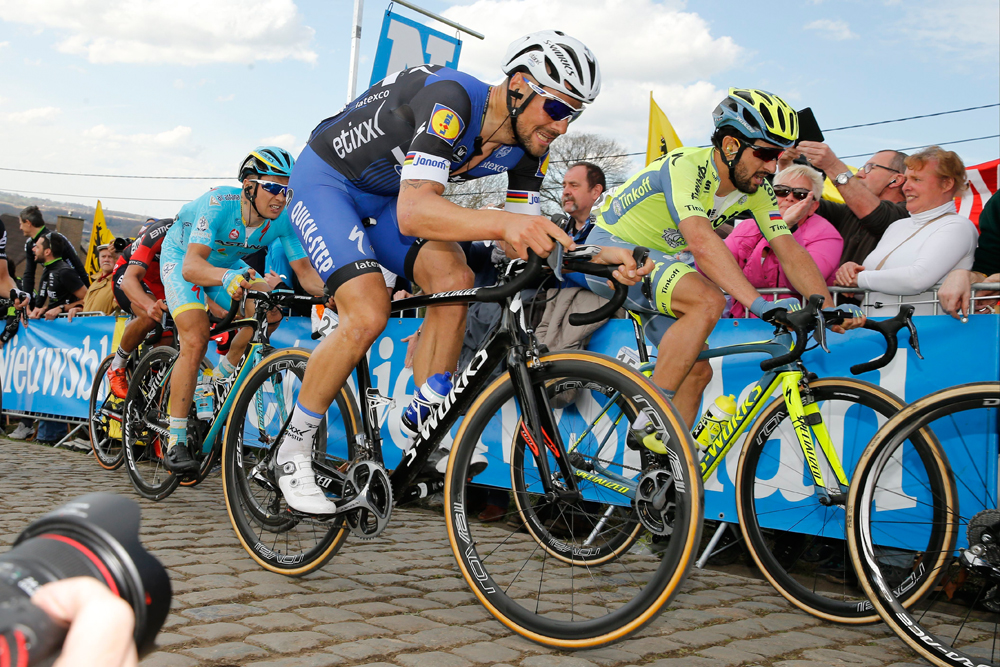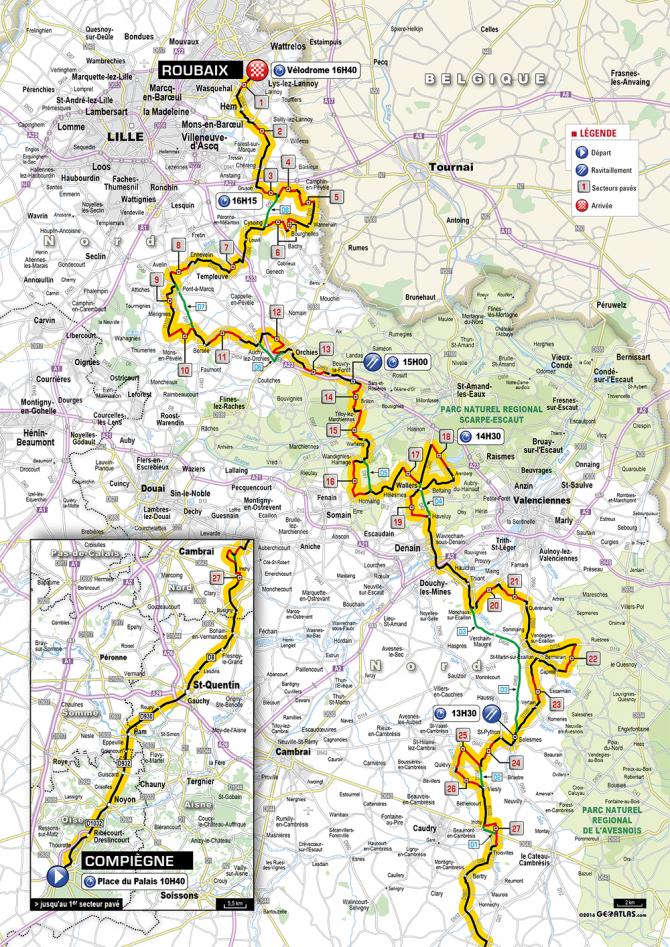2016 Paris-Roubaix race preview
Sagan and Cancellara headline









The Ardennes may await later in April, but across the Franco-Belgian border, Paris-Roubaix brings the curtain down on the spring's cobbled Classics on Sunday. It's the oldest, perhaps the most prestigious, probably the most iconic, of the lot.
From the merciless sectors of pavé that cut through the bleak, war-torn landscape of France's Nord département, to the finish on the concrete banks of the Roubaix velodrome, the dirt-encrusted faces of the riders, and the post-race open shower block where that grime is washed away; it is a race replete with idiosyncrasies.
Now in its 114th edition, the race was first held back in 1896, stopping for both world wars, and it was due to devastation wreaked by the first of those wars that the moniker 'The Hell of the North' was born. Thanks to the self-appointed custodians of the cobbles, Les Amis de Paris-Roubaix, riders still rattle across tracks that might otherwise have been paved over years ago and, though maintenance work is carried out, the cobblestones remain unevenly spaced, with grass and moss sprouting up in between – the most unforgiving pavé to be found in professional cycling.
With heavy rain forecast for Sunday, the already intimidating parcours takes on another dimension. There will be more than a few butterflies in the stomachs of riders as they try to get to sleep on Saturday night but, equally, more than a few fans rubbing their hands at the prospect.
If the heavens open, the mud will follow, and the race may well be assigned that hackneyed tag of 'epic'. There are certainly enough characters and potential storylines to make it so.
Can Peter Sagan pull off the Tour of Flanders - Paris-Roubaix double in the rainbow jersey? Will Fabian Cancellara take home the cobblestone trophy for a fourth time on his final appearance at the race? Can Tom Boonen become the only rider to triumph five times? Will that pair treat us to a final instalment of one of cycling's great rivalries?
Answers to those questions will have to wait a few days, while the build-up to one of the most eagerly anticipated races of the year unfolds.
The route
The pavé is what makes this race so iconic and the 2016 edition will subject riders to no fewer than 27 sectors of the rough stuff. That was the plan, at least. As it stands, there is the possibility that the first sector, in Troisvilles, will be removed due to the fact it is currently caked in mud and potentially too dangerous to cover.
A final decision will be made at the directeurs sportifs meeting on Saturday afternoon but if the route goes ahead as planned, there will be a total of 52.8 kilometres of pavé along the 257.5km journey from Compiègne to the Roubaix velodrome. There is something of a novelty in the inclusion of an uphill sector at Hameu du Buat after 127 kilometres, making its third appearance in the race, though for the most part race organiser Thierry Gouvenou is sticking with his tried and tested formula.
One of the race's many quirks is that it doesn't actually start in Paris, with Compiègne situated some 80 kilometres north east of the French capital. After the mid-morning roll-out, the first 100 kilometres start out in relatively benign fashion, though the slightly undulating roads and the drawn-out battle that is the formation of a breakaway in a race such as this conspire to make it a far from relaxing start.
Also read
- Paris-Roubaix provisional start list
- Top 10 riders to watch in Paris-Roubaix
- Rowe and Stannard share Sky leadership at Paris-Roubaix
- Paris-Roubaix previous winners
The cobblestones rear their heads for the first time at Troisvilles after 98.5km but it is traditionally held that the Arenberg Forest, 60km and eight sectors later, is where they truly start to unleash their hellish impact on the race. The first of three five-star sectors – they're rated out of five according to difficulty – Arenberg is 2400 metres long and always provides one of the iconic shots of the race as riders enter the arrow-straight corridor through the imposing, solemn birch trees. Positioning upon entry is of vital importance, and many riders have likened the approach to a full-on bunch sprint.
Seven further sectors contribute to the whittling-down effect ahead of the next notorious flashpoint, Mons-en-Pévèle, the second of the five-star sectors and the longest at an aching 3km. The Carrefour de l'Arbre, equally, has cemented its place as one of the crucial junctures of the race, the final five-star sector coming just 18km from the line, by which point the winning selections are being made.
The iconic finish sees riders come off the road and into the outdoor Roubaix velodrome for one-and-a-half laps of the concrete track and, such is the unpredictability of the race, the crowd may welcome a lone rider for a victory parade or a group for a ferociously contested sprint.

The contenders
There was a time when the Flanders-Roubaix double was rare; in the first 100 editions of the Hell of the North, the winner had come off the back of triumph across the Belgian border on just seven occasions. Peter Sagan will be relieved to note, however, that this trend has been turned on its head in recent years. Peter Van Petegem did the double in 2003, and the feat has been repeated a further four times since then – twice apiece by Cancellara and Boonen.
Though Sagan has only one top-10 finish to his name from four appearances at Paris-Roubaix (6th in 2014), he clearly has all the attributes to take victory and his form should strike fear into the rest of the riders. He has been a prominent force in all the one-day races he has entered this year and the fact he followed a string of near misses with a Gent-Wevelgem-Flanders double that proves he has peaked at the perfect time. Roubaix may turn out to be a more tactical affair than Flanders but he proved on Sunday he has the power and inclination to go solo, while his speed is such that few will want him for company in the velodrome.
Last year's winner John Degenkolb is absent as he recovers from the Giant-Alpecin training crash in January, while another would-be favourite, Greg Van Avermaet, was ruled out after breaking his collarbone at Flanders. Young Belgian Tiesj Benoot and Milan-San Remo winner Arnaud Démare are both doubts after also crashing at Flanders and it is likely they'd be below their best if are to start.
Fabian Cancellara is riding his final Paris-Roubaix and showed at Flanders – and indeed throughout this season – that this is not just a farewell procession. He missed the Sagan move but was far and away the strongest of the other riders and there's nothing to suggest he won't be able to bludgeon his way clear this Sunday.
You can't mention Cancellara without also mentioning Boonen. The pair have combined to contribute so much to the history of the Classics over the past 15 years and Boonen could further enshrine himself in cycling legend by winning what would be a record fifth Paris-Roubaix. At 35, he has seemed a level below Cancellara this season, and was hampered at Flanders by a wrist injury, but he nevertheless remains an outside bet and something of a romantic one.
And that brings us onto the Etixx-QuickStep conundrum. Unrivalled strength in depth, but unable to channel that into a major one-day win all season. Perhaps it has something to do with Boonen's waning powers; he no longer provides the foil that allowed teammates to skip away to victory, like Stijn Devolder's Flanders double in 2007 and 2008, or Niki Terpstra's Roubaix win in 2014. Terpstra remains one of the Belgian team's biggest threats, while Stijn Vandenbergh will roll the dice at some point but probably won't win. Perhaps their best card is Zdenek Stybar, the former cyclo-cross world champion, who was their best finisher (8th) at Flanders. The Czech rider has ridden Paris-Roubaix three times, finishing sixth, fifth, and second, so the signs certainly point to a breakthrough, especially if the muddy conditions enable him to dig into his 'cross arsenal.
Alexander Kristoff hasn't been able to match the remarkable form he showed last spring, though he will certainly become favourite if he makes it into the velodrome with the lead group. Team Sky have the two-pronged attack of Luke Rowe and Ian Stannard, the former enjoying a fine cobbled Classics campaign so far and a good bet to match his top-10 last year, the latter taking a tapered approach to the Monuments this year after winning early at Het Nieuwsblad the previous two seasons.
Sep Vanmarcke, always there or thereabouts, has finished 11th, 4th, and 2nd at Roubaix in the last three seasons and, after coming third at Flanders, should be there or thereabouts again. Also flying the flag for Belgium, in the absence of Van Avermaet and Benoot, is Jurgen Roelandts.
Lars Boom, also a former cyclo cross world champion, was fourth last year and famously won the cobbled stage in the 2014 Tour de France, so will certainly be a factor, while Edvald Boasson Hagen has raised expectations once more with his form this season, and the Norwegian says he should be at his best on Sunday.
The latest race content, interviews, features, reviews and expert buying guides, direct to your inbox!
Patrick is a freelance sports writer and editor. He’s an NCTJ-accredited journalist with a bachelor’s degree in modern languages (French and Spanish). Patrick worked full-time at Cyclingnews for eight years between 2015 and 2023, latterly as Deputy Editor.
Latest on Cyclingnews
-
Lauren Stephens fully committed to Aegis Foundation Cycling women's team as it heads toward 2026 rebrand as Next Step Racing
'I've always wanted to start a team' says two-time US gravel national champion who targets first-time appearance at Leadville Trail 100 MTB in August -
Amazon Prime Day Bike Deals Live: 33% off Garmin computers, Electric pumps and Tacx smart trainers
Deals on Canyon electric bikes, Adidas shoes, AirPods and more. Day three of Amazon Prime Day is here, and the sale is heating up -
Airpods Pro 2 vs Pixel Buds Pro 2: Battle of the Amazon Prime Day deals
With both options on offer for Amazon Prime Day, which should you part with your money for? -
Back pain forces Lotte Kopecky to abandon Giro d'Italia
'As a precaution ahead of the Tour de France Femmes, she is leaving the Giro d'Italia Women to take three to four days of complete rest' confirms SD Worx-Protime




